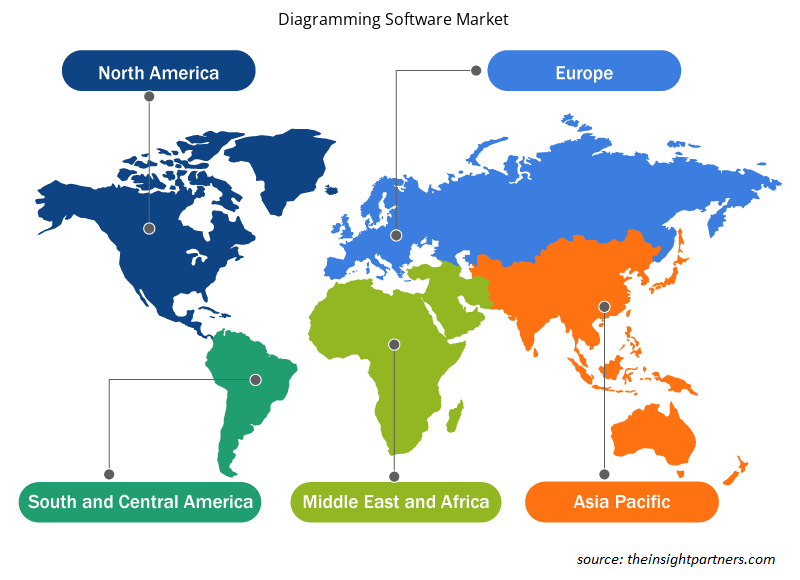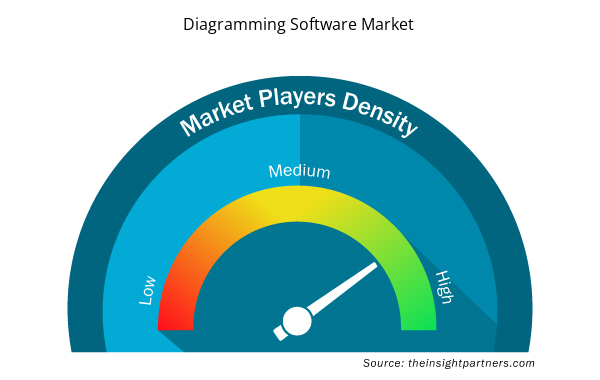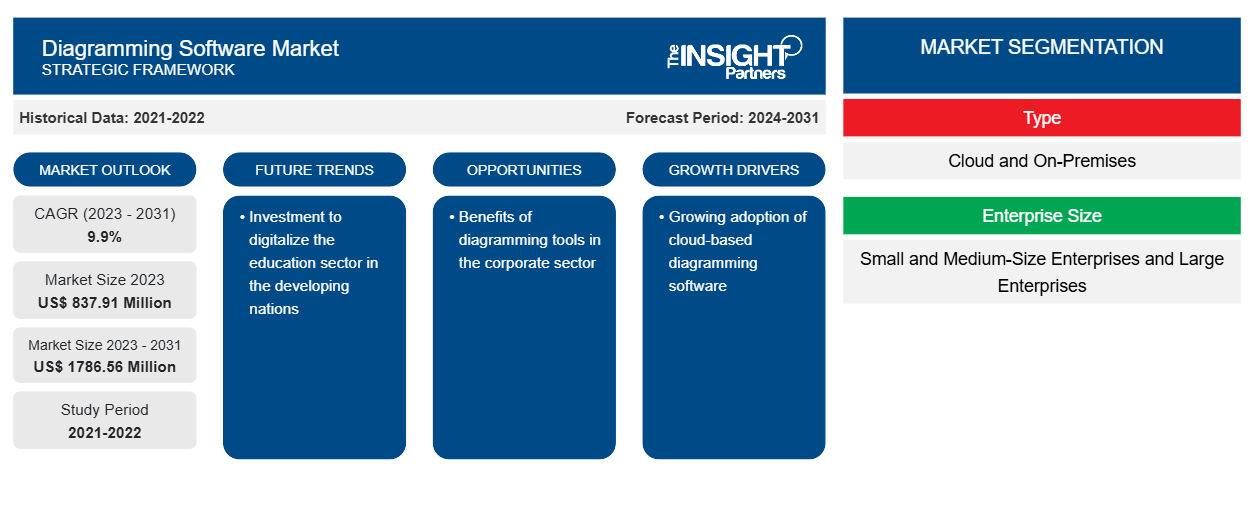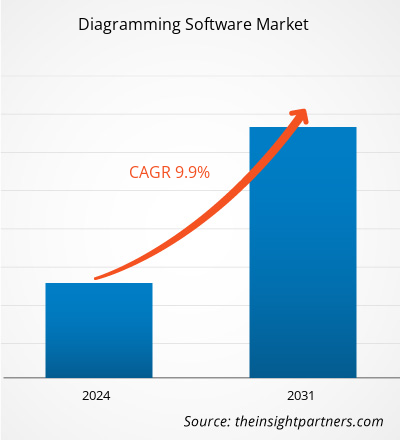Si prevede che la dimensione del mercato del software di diagrammazione raggiungerà 1786,56 milioni di dollari entro il 2031, rispetto agli 837,91 milioni di dollari del 2023. Si prevede che il mercato registrerà un CAGR del 9,9% nel periodo 2023-2031. L'aumento della digitalizzazione e la crescente adozione di software di diagrammazione basati su cloud rimarranno probabilmente tendenze chiave nel mercato.
Analisi di mercato del software di diagrammazione
Il mercato dei software di diagrammazione sta guadagnando terreno grazie alla crescente adozione da parte di grandi aziende e piccole e medie imprese. L'adozione di questo software li aiuta a definire meglio il flusso di lavoro e le operazioni nell'ambiente aziendale . Vari dipartimenti dell'organizzazione, come marketing, risorse umane, ingegneria e operazioni, possono utilizzarlo ampiamente.
Panoramica del mercato del software di diagrammi
Con l'aiuto del software di diagrammazione, l'utente può creare diagrammi dettagliati, che includono diagrammi di flusso, grafici a torta, planimetrie e altri diagrammi, basati su set di dati e immagini. Il software di diagrammazione include vari modelli che aiutano l'utente a creare il diagramma da zero. Questo software può essere facilmente integrato con altri strumenti e piattaforme in cui più utenti possono visualizzare e contribuire alla creazione del diagramma.
Personalizza questo report in base alle tue esigenze
Riceverai la personalizzazione gratuita di qualsiasi report, comprese parti di questo report, o analisi a livello nazionale, pacchetto dati Excel, oltre a usufruire di grandi offerte e sconti per start-up e università
- Scopri le principali tendenze di mercato in questo rapporto.Questo campione GRATUITO includerà analisi di dati che spaziano dalle tendenze di mercato alle stime e alle previsioni.
Driver e opportunità del mercato del software di diagrammazione
Vantaggi degli strumenti di diagrammazione nel settore aziendale
I diagrammi aiutano a ridurre la complessità della comunicazione. Nell'ambiente aziendale, i diagrammi forniscono una rappresentazione visiva chiara e concisa dei processi aziendali. Aiutano a comprendere tutti i dipendenti in merito agli obiettivi e ai processi che devono essere seguiti nell'implementazione del progetto. Con l'adozione di strumenti di diagrammazione, i team leader o i project manager possono fornire il flusso di lavoro del progetto ai propri dipendenti, spiegandolo con un diagramma. Il software di diagrammazione li aiuta a creare grafici a torta, diagrammi di flusso e molti altri diagrammi modello. La rappresentazione visiva del progetto o degli obiettivi aziendali aiuta i dipendenti a comprendere meglio le tendenze e l'ambito del progetto. Pertanto, le aziende stanno ampiamente adottando software di diagrammazione.
Adozione di software basati su cloud
Grazie all'aumento delle iniziative di industrializzazione e globalizzazione nei paesi sviluppati e in via di sviluppo, le attività commerciali stanno crescendo in tutti i settori. Inoltre, è stato osservato che le aziende stanno adottando la trasformazione digitale per ottenere un vantaggio competitivo e massimizzare la loro produttività. Per questo, l'azienda è alla ricerca di una soluzione conveniente, che sta portando all'adozione della soluzione software di diagrammazione basata su cloud .
Analisi della segmentazione del rapporto di mercato del software di diagrammazione
I segmenti chiave che hanno contribuito alla derivazione dell'analisi di mercato del software di creazione di diagrammi sono il tipo di distribuzione, le dimensioni aziendali e l'applicazione.
- In base al tipo di distribuzione, il mercato del software di diagrammazione è diviso in cloud e on-premise. Il segmento on-premise ha detenuto la quota maggiore del mercato nel 2023.
- In base alle dimensioni aziendali, il mercato è segmentato in piccole e medie imprese e grandi imprese. Si prevede che il segmento delle piccole e medie imprese crescerà con il CAGR più elevato.CAGR.
- In base alle dimensioni aziendali, il mercato è segmentato in istituti scolastici, aziende e personale. Il segmento degli istituti scolastici ha detenuto una quota significativa del mercato nel 2023.corporates, and personnel. The educational institutions segment held a significant share of the market in 2023.
Analisi della quota di mercato del software di diagrammazione per area geografica
L'ambito geografico del rapporto di mercato sui software di creazione di diagrammi è suddiviso principalmente in cinque regioni: Nord America, Asia Pacifico, Europa, Medio Oriente e Africa, Sud e Centro America.
La regione Asia-Pacifico detiene la quota di mercato più grande e si prevede che crescerà con il CAGR più elevato. Paesi come India, Giappone e Cina detengono la maggior parte della quota di mercato Asia-Pacifico. La crescente digitalizzazione è uno dei principali fattori che portano all'adozione di soluzioni digitali. Le crescenti piattaforme di e-learning e le crescenti PMI nelle nazioni in via di sviluppo stanno guidando l'adozione di soluzioni software di diagrammazione.CAGR. Countries such as India, Japan, and China hold the majority of the Asia-Pacific market share. The growing digitalization is one of the major factors leading to the adoption of digital solutions. Growing e-learning platforms and growing SMEs in developing nations are driving the adoption of diagramming software solutions.
Approfondimenti regionali sul mercato dei software di diagrammi
Le tendenze regionali e i fattori che influenzano il Diagramming Software Market durante il periodo di previsione sono stati ampiamente spiegati dagli analisti di Insight Partners. Questa sezione discute anche i segmenti e la geografia del Diagramming Software Market in Nord America, Europa, Asia Pacifico, Medio Oriente e Africa e Sud e Centro America.

- Ottieni i dati specifici regionali per il mercato del software di diagrammazione
Ambito del rapporto di mercato del software di diagrammi
| Attributo del report | Dettagli |
|---|---|
| Dimensioni del mercato nel 2023 | 837,91 milioni di dollari USA |
| Dimensioni del mercato entro il 2031 | 1786,56 milioni di dollari USA |
| CAGR globale (2023-2031) | 9,9% |
| Dati storici | 2021-2022 |
| Periodo di previsione | 2024-2031 |
| Segmenti coperti | Per tipo
|
| Regioni e Paesi coperti | America del Nord
|
| Leader di mercato e profili aziendali chiave |
|
Diagramma della densità dei player del mercato del software: comprendere il suo impatto sulle dinamiche aziendali
Il mercato del software di diagrammazione sta crescendo rapidamente, spinto dalla crescente domanda degli utenti finali dovuta a fattori quali l'evoluzione delle preferenze dei consumatori, i progressi tecnologici e una maggiore consapevolezza dei vantaggi del prodotto. Con l'aumento della domanda, le aziende stanno ampliando le loro offerte, innovando per soddisfare le esigenze dei consumatori e capitalizzando sulle tendenze emergenti, il che alimenta ulteriormente la crescita del mercato.
La densità degli operatori di mercato si riferisce alla distribuzione di aziende o società che operano in un particolare mercato o settore. Indica quanti concorrenti (operatori di mercato) sono presenti in un dato spazio di mercato in relazione alle sue dimensioni o al valore di mercato totale.
Le principali aziende che operano nel mercato dei software per la creazione di diagrammi sono:
- Creativamente
- disegnare.io
- Gliffy di Perforce
- Edrawsoft
- Grafico Lucido
- Microsoft
Disclaimer : le aziende elencate sopra non sono classificate secondo un ordine particolare.

- Ottieni la panoramica dei principali attori del mercato dei software di diagrammazione
Notizie di mercato e sviluppi recenti del software di diagrammazione
Il mercato del software di diagrammazione viene valutato raccogliendo dati qualitativi e quantitativi dopo la ricerca primaria e secondaria, che include importanti pubblicazioni aziendali, dati di associazioni e database. Di seguito sono elencati alcuni degli sviluppi nel mercato del software di diagrammazione:
- Google ha lanciato il nuovissimo Google Cloud Architecture Diagramming Tool. Questo strumento consente all'utente di condividere la visione con il team, collaborare con loro, iterare sulla progettazione e creare la versione finale che meglio soddisfa i requisiti per il caso d'uso aziendale. (Fonte: Google, comunicato stampa, febbraio 2022)
- EdrawMax, un software leader per la creazione di diagrammi, ha lanciato la sua versione mobile, l'app EdrawMax, progettata per consentire agli utenti di creare facilmente diagrammi di flusso e diagrammi a blocchi professionali. Migliorando la produttività e risparmiando tempo agli utenti, la nuova app offre oltre 20.000 modelli di diagrammi di alta qualità che gli utenti possono personalizzare e modificare per creare diagrammi dall'aspetto raffinato. (Fonte: PRNewswire, comunicato stampa, aprile 2023)
Copertura e risultati del rapporto di mercato sul software di diagrammazione
Il rapporto "Dimensioni e previsioni del mercato del software di diagrammi (2021-2031)" fornisce un'analisi dettagliata del mercato che copre le seguenti aree:
- Dimensioni e previsioni del mercato del software di diagrammazione a livello globale, regionale e nazionale per tutti i segmenti di mercato chiave coperti dall'ambito
- Diagramma delle tendenze del mercato del software, nonché dinamiche di mercato quali driver, vincoli e opportunità chiave
- Analisi dettagliata delle cinque forze PEST/Porter e SWOT
- Analisi di mercato del software di diagrammazione che copre le principali tendenze del mercato, il quadro globale e regionale, i principali attori, le normative e i recenti sviluppi del mercato
- Analisi del panorama industriale e della concorrenza che copre la concentrazione del mercato, l'analisi della mappa di calore, i principali attori e gli sviluppi recenti per il mercato del software di creazione di diagrammi
- Profili aziendali dettagliati
- Analisi storica (2 anni), anno base, previsione (7 anni) con CAGR
- Analisi PEST e SWOT
- Valore/volume delle dimensioni del mercato - Globale, regionale, nazionale
- Industria e panorama competitivo
- Set di dati Excel



Report Coverage
Revenue forecast, Company Analysis, Industry landscape, Growth factors, and Trends

Segment Covered
This text is related
to segments covered.

Regional Scope
North America, Europe, Asia Pacific, Middle East & Africa, South & Central America

Country Scope
This text is related
to country scope.
Domande frequenti
The estimated value of the diagramming software market will be US$ 1786.56 million by 2031.
Creately, draw.io, Gliffy by Perforce, Edrawsoft, Lucidchart, Microsoft, FigJam, MyDraw, NULAB, and SmartDraw are some of the key players operating in the diagramming software market.
Investment to digitalize the education sector in developing nations is considered a key trend in the diagramming software market.
The rise in digitalization and growing adoption of cloud-based diagramming software are the key driving factors impacting the diagramming software market.
The global diagramming software market is estimated to register a CAGR of 9.9% during the forecast period 2023–2031.
Trends and growth analysis reports related to Technology, Media and Telecommunications : READ MORE..
The Insight Partners performs research in 4 major stages: Data Collection & Secondary Research, Primary Research, Data Analysis and Data Triangulation & Final Review.
- Data Collection and Secondary Research:
As a market research and consulting firm operating from a decade, we have published and advised several client across the globe. First step for any study will start with an assessment of currently available data and insights from existing reports. Further, historical and current market information is collected from Investor Presentations, Annual Reports, SEC Filings, etc., and other information related to company’s performance and market positioning are gathered from Paid Databases (Factiva, Hoovers, and Reuters) and various other publications available in public domain.
Several associations trade associates, technical forums, institutes, societies and organization are accessed to gain technical as well as market related insights through their publications such as research papers, blogs and press releases related to the studies are referred to get cues about the market. Further, white papers, journals, magazines, and other news articles published in last 3 years are scrutinized and analyzed to understand the current market trends.
- Primary Research:
The primarily interview analysis comprise of data obtained from industry participants interview and answers to survey questions gathered by in-house primary team.
For primary research, interviews are conducted with industry experts/CEOs/Marketing Managers/VPs/Subject Matter Experts from both demand and supply side to get a 360-degree view of the market. The primary team conducts several interviews based on the complexity of the markets to understand the various market trends and dynamics which makes research more credible and precise.
A typical research interview fulfils the following functions:
- Provides first-hand information on the market size, market trends, growth trends, competitive landscape, and outlook
- Validates and strengthens in-house secondary research findings
- Develops the analysis team’s expertise and market understanding
Primary research involves email interactions and telephone interviews for each market, category, segment, and sub-segment across geographies. The participants who typically take part in such a process include, but are not limited to:
- Industry participants: VPs, business development managers, market intelligence managers and national sales managers
- Outside experts: Valuation experts, research analysts and key opinion leaders specializing in the electronics and semiconductor industry.
Below is the breakup of our primary respondents by company, designation, and region:

Once we receive the confirmation from primary research sources or primary respondents, we finalize the base year market estimation and forecast the data as per the macroeconomic and microeconomic factors assessed during data collection.
- Data Analysis:
Once data is validated through both secondary as well as primary respondents, we finalize the market estimations by hypothesis formulation and factor analysis at regional and country level.
- Macro-Economic Factor Analysis:
We analyse macroeconomic indicators such the gross domestic product (GDP), increase in the demand for goods and services across industries, technological advancement, regional economic growth, governmental policies, the influence of COVID-19, PEST analysis, and other aspects. This analysis aids in setting benchmarks for various nations/regions and approximating market splits. Additionally, the general trend of the aforementioned components aid in determining the market's development possibilities.
- Country Level Data:
Various factors that are especially aligned to the country are taken into account to determine the market size for a certain area and country, including the presence of vendors, such as headquarters and offices, the country's GDP, demand patterns, and industry growth. To comprehend the market dynamics for the nation, a number of growth variables, inhibitors, application areas, and current market trends are researched. The aforementioned elements aid in determining the country's overall market's growth potential.
- Company Profile:
The “Table of Contents” is formulated by listing and analyzing more than 25 - 30 companies operating in the market ecosystem across geographies. However, we profile only 10 companies as a standard practice in our syndicate reports. These 10 companies comprise leading, emerging, and regional players. Nonetheless, our analysis is not restricted to the 10 listed companies, we also analyze other companies present in the market to develop a holistic view and understand the prevailing trends. The “Company Profiles” section in the report covers key facts, business description, products & services, financial information, SWOT analysis, and key developments. The financial information presented is extracted from the annual reports and official documents of the publicly listed companies. Upon collecting the information for the sections of respective companies, we verify them via various primary sources and then compile the data in respective company profiles. The company level information helps us in deriving the base number as well as in forecasting the market size.
- Developing Base Number:
Aggregation of sales statistics (2020-2022) and macro-economic factor, and other secondary and primary research insights are utilized to arrive at base number and related market shares for 2022. The data gaps are identified in this step and relevant market data is analyzed, collected from paid primary interviews or databases. On finalizing the base year market size, forecasts are developed on the basis of macro-economic, industry and market growth factors and company level analysis.
- Data Triangulation and Final Review:
The market findings and base year market size calculations are validated from supply as well as demand side. Demand side validations are based on macro-economic factor analysis and benchmarks for respective regions and countries. In case of supply side validations, revenues of major companies are estimated (in case not available) based on industry benchmark, approximate number of employees, product portfolio, and primary interviews revenues are gathered. Further revenue from target product/service segment is assessed to avoid overshooting of market statistics. In case of heavy deviations between supply and demand side values, all thes steps are repeated to achieve synchronization.
We follow an iterative model, wherein we share our research findings with Subject Matter Experts (SME’s) and Key Opinion Leaders (KOLs) until consensus view of the market is not formulated – this model negates any drastic deviation in the opinions of experts. Only validated and universally acceptable research findings are quoted in our reports.
We have important check points that we use to validate our research findings – which we call – data triangulation, where we validate the information, we generate from secondary sources with primary interviews and then we re-validate with our internal data bases and Subject matter experts. This comprehensive model enables us to deliver high quality, reliable data in shortest possible time.


 Ottieni un campione gratuito per questo repot
Ottieni un campione gratuito per questo repot